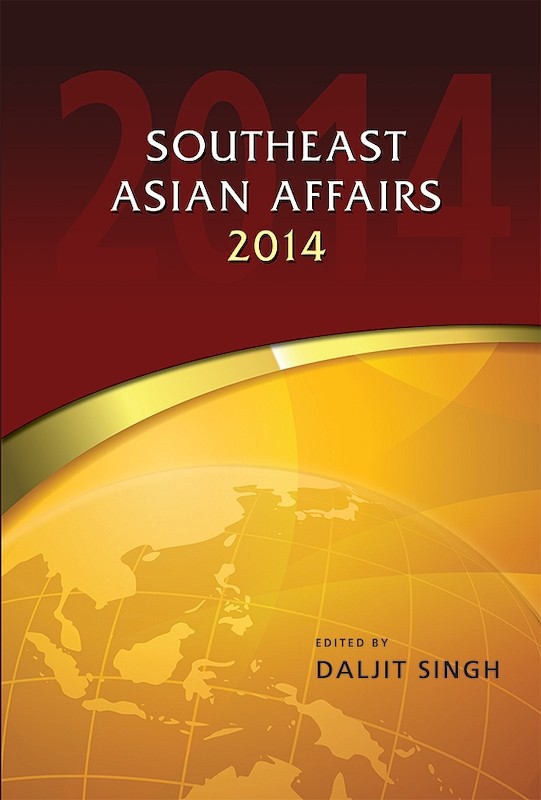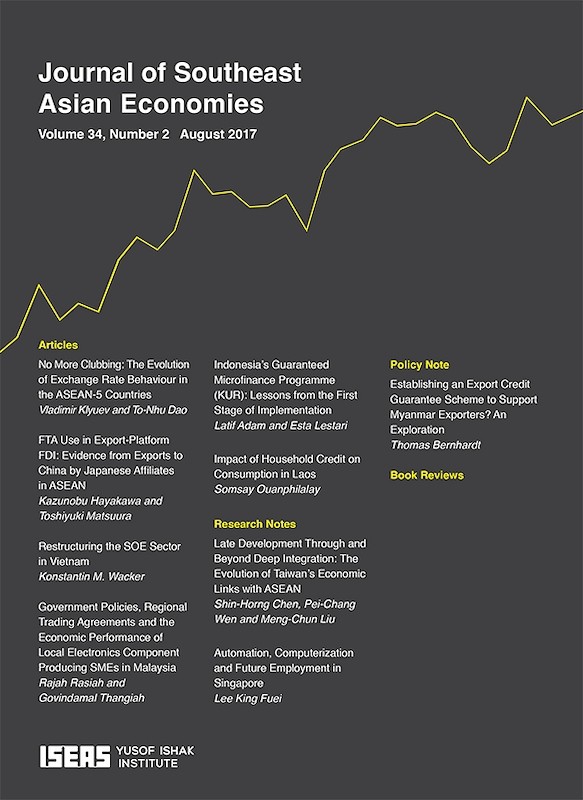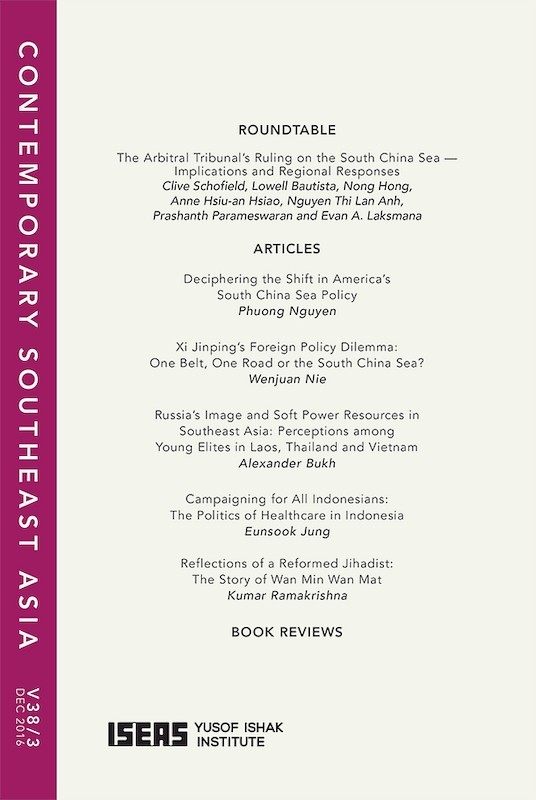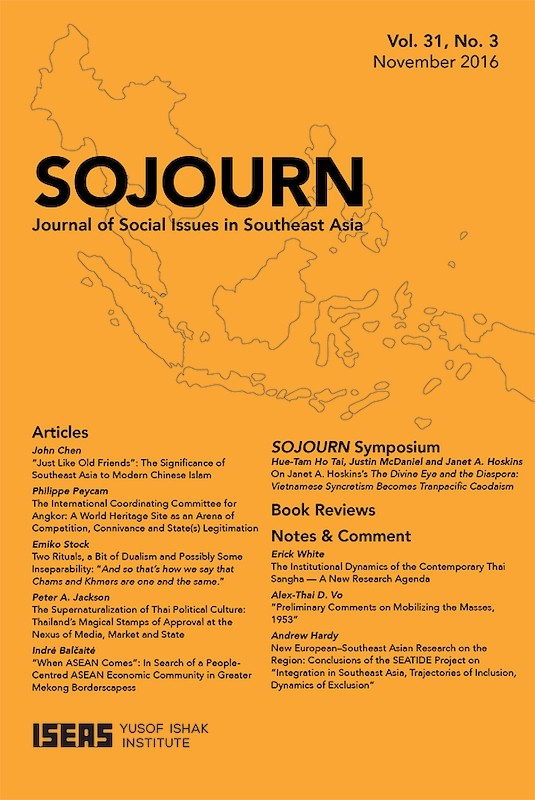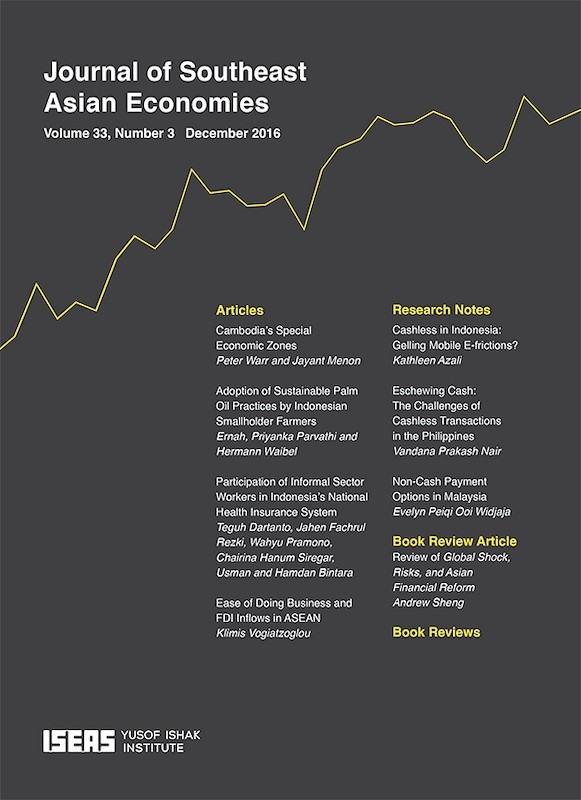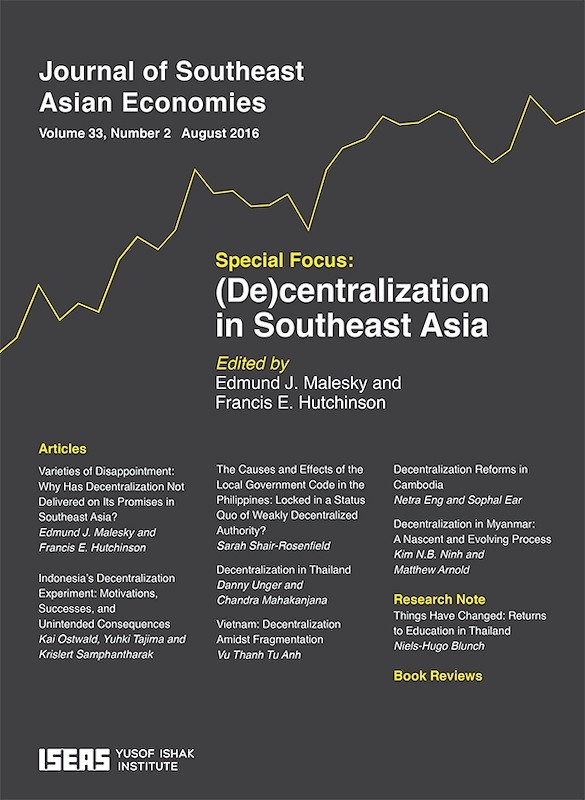SOJOURN: Journal of Social Issues in Southeast Asia Vol. 32/3 (November 2017)
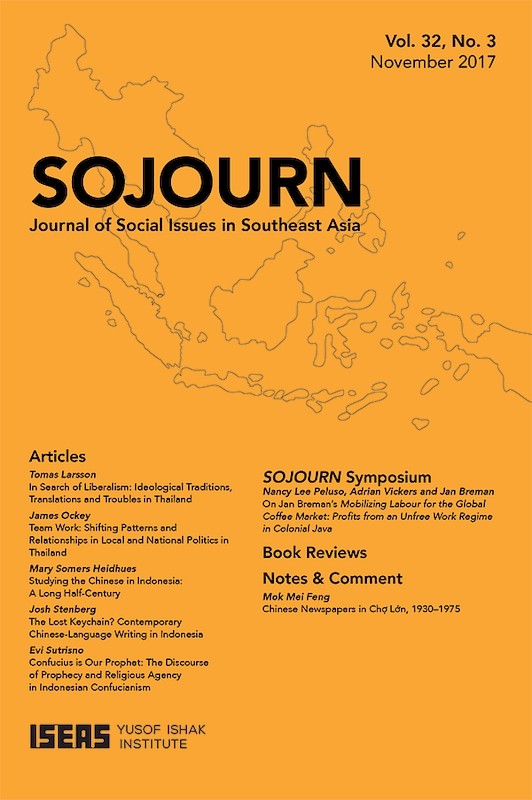
Michael J Montesano, editor
Date of publication:
November 2017
Publisher:
ISEAS – Yusof Ishak Institute
Number of pages:
252
Code:
SJ32/3
Contents
-
SOJOURN: Journal of Social Issues in Southeast Asia Vol. 32/3 (November 2017)
[Whole Publication, ISSN: 17932858] -
Preliminary pages
- ARTICLES
-
In Search of Liberalism: Ideological Traditions, Translations and Troubles in Thailand, by Tomas Larsson, author see abstractThe history of political thought in Southeast Asia has overwhelmingly focused on nationalism and on socialism and Marxism. Little has been written about the fate of liberalism in the region. This is in stark contrast with the literature that in recent years has emerged on liberal political thought in South and East Asian contexts. Seeking to make a Southeast Asian contribution to this literature, this article asks: Is there liberalism in Thailand? To answer the question, it surveys the existing literature on Thai political thought, outlines the history of the reproduction of the Western liberal canon in Thai translation, and takes stock of contemporary political debates. What does it find? First, that while one might find liberals in Thai history, there is no liberalism. Second, that serious intellectual engagement with liberal political thought occurred comparatively late and has remained modest in Thailand, but that the spectre of Rousseau has nevertheless stalked Thai politics for more than eight decades. Third, and finally, that some Thai intellectual historians and other writers have responded to the country's recent political troubles — in the form of increasing political polarization, intractable and often violent conflict, two military coups, and the ill health and subsequent death of King Bhumibol — by laying the intellectual groundwork for a liberal form of Thai nationalism.
-
Team Work: Shifting Patterns and Relationships in Local and National Politics in Thailand, by James Ockey, author see abstractMuch has been written about the changing relationship between parties and voters in Thailand during a period in which party loyalty has grown stronger. Scholars have devoted much less attention to the new patterns of relationships that have emerged between parties and provincial politicians. These patterns, which are with some variations common to all parties, have seen both parties and provincial politicians benefit from shared voter loyalties and from the political patronage available at the local level. The findings presented here highlight the importance of local politics — in securing access to government resources, in indirect support of political parties and in deterring both authoritarianism and the emergence of a more competitive democracy.
-
Studying the Chinese in Indonesia: A Long Half-Century, by Mary Somers Heidhues, author see abstractIn the years since Indonesian independence, English-language works have dominated studies of Indonesian Chinese. A brief survey of influential researchers and their topics since Indonesian independence traces changes in scholarly interest from citizenship and assimilation to regional diversity, culture and identity, economic activity, religion and literature. Increasingly, researchers are themselves Indonesians and other Asians, and their home institutions range from Western countries to Southeast Asia.
-
The Lost Keychain? Contemporary Chinese-Language Writing in Indonesia, by Josh Stenberg, author see abstractSince it constitutes an autonomous and identifiable <i>oeuvre</i> with considerable internal coherence, the most respectful approach to the substantial body of Chinese-language writing in Indonesia is to examine it on its own terms. While both a Chinese-language and an Indonesian literature, it is not well-served if read as one subordinate to broader categories; nor does it map convincingly to current ideas about Sinophone literature. Rather, the themes and social practice of this <i>oeuvre</i> demonstrate not only a distinct negotiation of Chinese identity generally but also the role of Chinese-language literary expression in <i>Reformasi</i>-era Indonesia specifically.
-
Confucius is Our Prophet: The Discourse of Prophecy and Religious Agency in Indonesian Confucianism, by Evi Lina Sutrisno, author see abstractComparison of four biographies of Confucius, published between 1897 and 1957, and a drama depicting his birth, performed in 2011, demonstrates the introduction of Confucius and his construction as a prophet in the Dutch East Indies and, later, in Indonesia. Supernatural and mystical elements serve as indispensable markers of religion and status as a prophet. The authors exercised agency in selecting and appropriating narratives of Confucius for their own purposes. The rationalist approach to the interpretation of Confucianism and the role of Confucius treats him as an historical figure, sage and teacher, while the spiritualist approach perceives him as a divine messenger, saviour and prophet. The two have long been in competition. The social and political struggles of Confucian communities since the Dutch colonial period have shaped literary and visual descriptions of Confucius.
- SOJOURN SYMPOSIUM
-
On Mobilizing Labour for the Global Coffee Market: Profits from an Unfree Work Regime in Colonial Java by Jan Breman, by Nancy Lee Peluso, Adrian Vickers, Jan Breman, authors
- BOOK REVIEWS
-
BOOK REVIEW: The Palace Law of Ayutthaya and the Thammasat: Law and Kingship in Siam, translated and edited by Chris Baker and Pasuk Phongpaichit, by Patrick Jory, author
-
BOOK REVIEW: Trams, Buses, and Rails: The History of Urban Transport in Bangkok, 1886–2010, by Kakizaki Ichiro, by Michael J Montesano, author
-
BOOK REVIEW: Hamka's Great Story: A Master Writer's Vision of Islam for Modern Indonesia, by James R. Rush, by Norshahril Saat, author
-
BOOK REVIEW: Area Studies at the Crossroads: Knowledge Production after the Mobility Turn, edited by Katja Mielke and Anna-Katharina Hornidge, by Victor T King, author
-
BOOK REVIEW: A History of Southeast Asia: Critical Crossroads, by Anthony Reid, by Michael Yeo Chai Ming, author
-
BOOK REVIEW: Nalanda, Srivijaya and Beyond: Re-exploring Buddhist Art in Asia, edited by Gauri Parimoo Krishnan, by Véronique Degroot, author
- NOTES & COMMENT
-
Chinese Newspapers in Chợ Lớn, 1930–1975, by Mok Mei Feng, author see abstractIn the mid-twentieth century, <span style="color: rgb(33, 29, 30); font-family: Arial; font-size: 10pt;">Chợ Lớn </span>was a powerhouse of Chinese newspaper publishing in Southeast Asia. A number of the major Chinese newspapers published there during that period are available in the Chinese Library of the National University of Singapore. The contents of these publications — editorials, commercial advertisements, personal advertisements, serialized novels — will be of interest to scholars of Sinophone studies and of modern Vietnamese history.<style> <!-- /* Font Definitions */ @font-face {font-family:Arial; panose-1:2 11 6 4 2 2 2 2 2 4; mso-font-charset:0; mso-generic-font-family:auto; mso-font-pitch:variable; mso-font-signature:-536859905 -1073711037 9 0 511 0;} @font-face {font-family:"MS 明朝"; mso-font-charset:78; mso-generic-font-family:auto; mso-font-pitch:variable; mso-font-signature:1 134676480 16 0 131072 0;} @font-face {font-family:"MS 明朝"; mso-font-charset:78; mso-generic-font-family:auto; mso-font-pitch:variable; mso-font-signature:1 134676480 16 0 131072 0;} /* Style Definitions */ p.MsoNormal, li.MsoNormal, div.MsoNormal {mso-style-unhide:no; mso-style-qformat:yes; mso-style-parent:""; margin:0pc; margin-bottom:.0001pt; mso-pagination:widow-orphan; font-size:12.0pt; font-family:Cambria; mso-ascii-font-family:Cambria; mso-ascii-theme-font:minor-latin; mso-fareast-font-family:"MS 明朝"; mso-fareast-theme-font:minor-fareast; mso-hansi-font-family:Cambria; mso-hansi-theme-font:minor-latin; mso-bidi-font-family:"Times New Roman"; mso-bidi-theme-font:minor-bidi; mso-ansi-language:EN-US;} p.MsoFootnoteText, li.MsoFootnoteText, div.MsoFootnoteText {mso-style-unhide:no; mso-style-link:"Footnote Text Char"; margin:0pc; margin-bottom:.0001pt; text-align:justify; text-justify:inter-ideograph; text-indent:1.5pc; mso-pagination:widow-orphan; font-size:12.0pt; mso-bidi-font-size:11.0pt; font-family:"Times New Roman"; mso-fareast-font-family:"MS 明朝"; mso-fareast-theme-font:minor-fareast; mso-bidi-font-family:"Times New Roman"; mso-bidi-theme-font:minor-bidi; mso-ansi-language:EN-US; mso-bidi-language:EN-US;} span.FootnoteTextChar {mso-style-name:"Footnote Text Char"; mso-style-unhide:no; mso-style-locked:yes; mso-style-link:"Footnote Text"; mso-bidi-font-size:11.0pt; font-family:"Times New Roman"; mso-ascii-font-family:"Times New Roman"; mso-hansi-font-family:"Times New Roman"; mso-bidi-language:EN-US;} p.Default, li.Default, div.Default {mso-style-name:Default; mso-style-unhide:no; mso-style-parent:""; margin:0pc; margin-bottom:.0001pt; mso-pagination:none; mso-layout-grid-align:none; text-autospace:none; font-size:12.0pt; font-family:"Times New Roman"; mso-fareast-font-family:"MS 明朝"; mso-fareast-theme-font:minor-fareast; color:black; mso-ansi-language:EN-US;} .MsoChpDefault {mso-style-type:export-only; mso-default-props:yes; font-family:Cambria; mso-ascii-font-family:Cambria; mso-ascii-theme-font:minor-latin; mso-fareast-font-family:"MS 明朝"; mso-fareast-theme-font:minor-fareast; mso-hansi-font-family:Cambria; mso-hansi-theme-font:minor-latin; mso-bidi-font-family:"Times New Roman"; mso-bidi-theme-font:minor-bidi; mso-ansi-language:EN-US;} @page WordSection1 {size:595.0pt 841.9pt; margin:6.0pc 7.5pc 6.0pc 7.5pc; mso-header-margin:2.95pc; mso-footer-margin:2.95pc; mso-paper-source:0;} div.WordSection1 {page:WordSection1;} --> </style>

